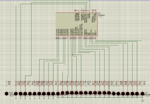kobre98
Full Member level 2
- Joined
- Sep 18, 2011
- Messages
- 145
- Helped
- 0
- Reputation
- 0
- Reaction score
- 0
- Trophy points
- 1,296
- Location
- Gaza, Palestine
- Activity points
- 2,523
hi guys,
i'm having troubles
i'm building a led globe, that has 30 led connected to pic16f877a
i connect each led with 120 ohm resistor since it can handle only 3 volt,
i need to send data as fast as 1905 micro second for each output
i want to send the earth map so i divided it to 64*30
where each one of the 64 coloumn is send with a delay of 1905 micro so i can make complete cycle that will show the earth
the problem is that when i send normal data to pins with millisecond delay it works fine like when i light five leds each time
but when i try to send the earth data with 64 colomun with the mentioned delay it start to behave in a wired way
the 30 led light at first shown a very low light then when i play with the + nd - wires of the main supply it light strongly but not correctly
so the question is
what type of crystal should i use for such thing ?
and what are the burn properties
i used 20mhz crystal and burn the code with HS enabled ?!
i'm having troubles
i'm building a led globe, that has 30 led connected to pic16f877a
i connect each led with 120 ohm resistor since it can handle only 3 volt,
i need to send data as fast as 1905 micro second for each output
i want to send the earth map so i divided it to 64*30
where each one of the 64 coloumn is send with a delay of 1905 micro so i can make complete cycle that will show the earth
the problem is that when i send normal data to pins with millisecond delay it works fine like when i light five leds each time
but when i try to send the earth data with 64 colomun with the mentioned delay it start to behave in a wired way
the 30 led light at first shown a very low light then when i play with the + nd - wires of the main supply it light strongly but not correctly
so the question is
what type of crystal should i use for such thing ?
and what are the burn properties
i used 20mhz crystal and burn the code with HS enabled ?!
